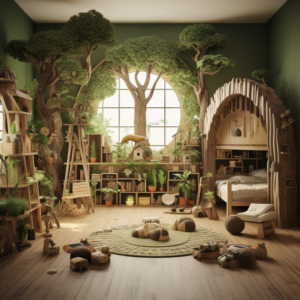In the world of interior design, minimalism and eco-friendliness are two trends that have gained significant traction in recent years. While they may seem like distinct concepts, they share a common philosophy: less is more. In this article, we’ll explore how minimalism and eco-friendly design can be combined to create harmonious and sustainable living spaces.
1. Simplified Design
Minimalism is characterized by simplicity and a focus on essential elements. By reducing clutter and eliminating unnecessary decor, you not only achieve a clean and uncluttered look but also reduce the consumption of materials and resources. Eco-friendly design aligns with this principle by encouraging a mindful approach to resource usage.
2. Sustainable Materials
Both minimalism and eco-friendly design prioritize the use of sustainable and environmentally friendly materials. Opt for furnishings, flooring, and decor made from renewable resources like bamboo, reclaimed wood, or recycled metals. These choices minimize the environmental impact of your space.
3. Energy Efficiency
Minimalist design often emphasizes natural light and open spaces. This not only creates a sense of airiness but also reduces the need for artificial lighting and heating, leading to energy savings. Incorporate energy-efficient appliances and lighting to further enhance sustainability.
4. Decluttered Spaces
Minimalist interiors promote decluttered spaces with only essential items on display. This approach reduces the need for excess storage and encourages responsible consumption. Eco-friendly design complements this by advocating for the reuse and repurposing of items rather than constantly acquiring new ones.
5. Mindful Consumption
Minimalism encourages a mindful approach to consumption, urging you to assess the true value of each item in your home. Eco-friendly design echoes this sentiment by discouraging the purchase of disposable or single-use products and promoting the longevity of items.
6. Reduced Waste
By adhering to minimalist principles, you inherently reduce waste in your living space. Eco-friendly design extends this commitment by encouraging recycling, composting, and responsible disposal of materials to minimize landfill contributions.
7. Biophilic Design
Biophilic design, which integrates natural elements into indoor spaces, aligns with both minimalism and eco-friendly design. Incorporating plants, natural materials, and sustainable greenery enhances the aesthetic appeal of minimalistic interiors while promoting a connection with nature.
8. Eco-Conscious Decor
When selecting decor items, choose those made from eco-friendly materials or repurpose existing items. Minimalist decor focuses on a few carefully chosen pieces, making it easier to prioritize sustainable choices.
9. Sustainability in Color
Minimalism often employs a neutral color palette, which can be complemented by eco-friendly paint options that contain low or zero VOCs. These paints contribute to healthier indoor air quality.
10. Long-Term Investment
Both minimalism and eco-friendly design advocate for long-lasting, quality items that are built to endure. This approach reduces the need for frequent replacements and curbs excessive consumption.
By embracing the synergy of minimalism and eco-friendly design, you can create living spaces that are not only aesthetically pleasing but also sustainable and responsible. These design philosophies encourage a mindful and intentional approach to your environment, fostering a more eco-conscious way of living for a brighter and greener future.

